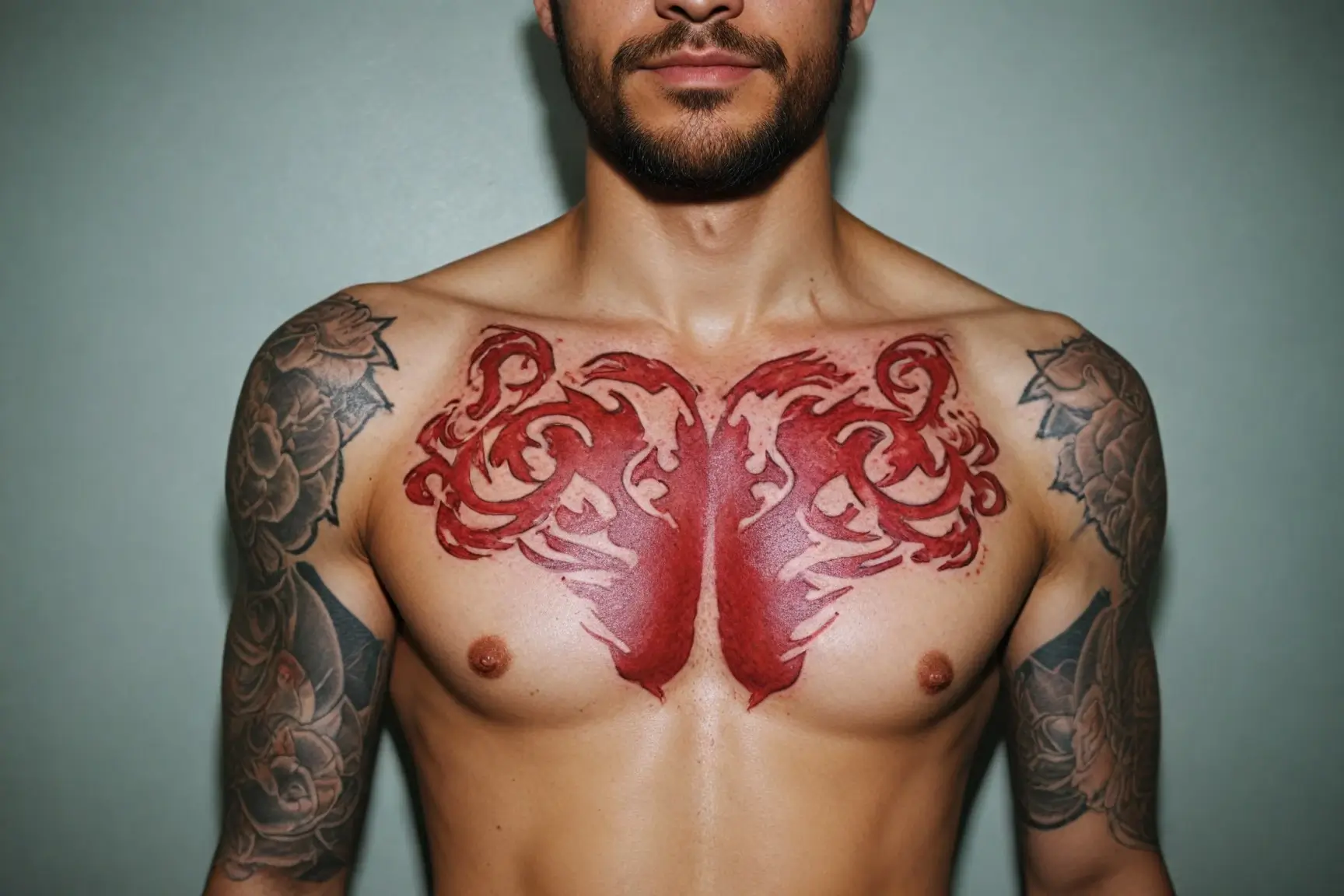Red ink tattoos have become very famous due to their dynamic and striking appearance. However, it also comes with creative considerations regarding healing, aftercare, design and safety. Discover different aspects of red ink tattoos such as effects on different skin tones, allergies, the healing process, and necessary aftercare practices.
What Is Red Ink Tattoo?
The use of red ink in tattoos represents passion, love, and intensity, and is often associated with emotions. Compared to other ink colours, red ink comes with a very high risk of allergic reactions and skin sensitivity. Certain heavy metals and pigments, such as mercury and carmine, can cause adverse reactions to the skin, which increases the risk of skin cancer.

“Cinnabar is a metal that is based on mercury, which is used to make red pigments. Also, tattoo inks contain carriers (liquids) that facilitate their adhesion to the skin. Inks for red tattoos are usually formulated with glycerin, water, isopropyl alcohol, and acrylic resin.”
How to Avoid Red Ink Side Effects?
Most of the time red tattoo pigment or particles will be the reason for negative reactions in the sensitive body such as itchy skin and allergic reactions. People who get red ink tattoos often report bumps, skin reactions, and itchiness, even with the best, minimum toxic inks available.
Red ink is used on the body in just small amounts, but many tattoo clients want complete red tattoos. Ensure you discuss possible side effects they might encounter and how they can avoid them with them.
Red Ink Tattoos Healing
Red ink tattoo healing requires more attention to certain aftercare guides to reduce complications. These steps are very important for the healing process. You need to consider them:
- Keeping the Tattoo Clean: Wash the tattoo area regularly with antimicrobial soap to stop infections.
- Moisturizing: Use a fragrance-free, hypoallergenic moisturizer to keep the area hydrated, helping to reduce flaking and itching.
- Avoiding Sun Exposure: Sun exposure can fade red tattoos more quickly, so when outdoors, make sure you wear sunscreen that has a high SPF value.
- Monitoring for Reactions: You need to look at signs of allergic reactions, such as too much redness, swelling, or pain. If any suspicious symptoms occur, consult a healthcare provider quickly.
Red Ink Tattoos on Dark Skin
The visibility and intensity of red ink tattoos can differ greatly on darker skin tones. Normally, on dark skin, the color appearance is less vibrant than white skin, which can majorly affect the overall result and the beauty of the tattoo. This will be the reason for a less defined appearance over time, as the ink can combine with skin tone. Tattoo artists must choose tattoos that are prominently correct with experience working on darker skin types.

Red Ink Tattoo Allergy
Allergic reactions are among the most common complications of red ink tattoos. Symptoms include:
- Itchy or sensitive skin
- Redness and swelling
- Painful sensations upon contact
Reaction signs can happen instantly or develop over time, sometimes in the years after a tattoo is applied. Inks with toxic metals found in their pigments, such as red ink, are particularly prone to these issues. Whenever there is an allergic reaction, it is very important to seek medical advice immediately.
Is Red Ink Fade Faster?
According to my a lot of experts and famous artists experience that, red ink fades faster and will lose its vibrancy over time as compared to dark or black-coloured ink. In this case, it is best avoided as an outline color. Some colors will fade more quickly than red like orange and yellow, while red tattoos may need regular touch-ups.

How Often Do Red Ink Tattoos Need Touch-ups
Red ink tattoos normally need more touch-ups than other coloured tattoos. The reason is that there are more chances to fade faster, that’s why you need it. To maximize your red tattoo’s longevity and shine, do frequent tattoo touch-ups. There is no fixed time for how often red ink tattoos need touch-ups. They are different and depend on individual factors like sun exposure, aftercare practices, and skin type.
Red Ink Tattoo Aftercare
Tattoos need proper care because it is important for their vibrantness and appearance. You need to follow these important aftercare steps for red ink tattoos:
- Follow Artist’s Instructions: Follow your tattoo artist’s aftercare instructions, which normally include moisturizing and cleaning the tattoo.
- Wear Loose Clothing: You need to wear loose clothing to reduce irritation during the healing process, which could be the reason for rubbing against the tattoo.
- Avoid Swimming: Do not swim in pools, hot tubs, or baths If you have a tattoo that has not completely healed, you can do it when you are sure it is fully healed.
- Stay Hydrated: Healthy food is important for the body and drinking too much water it can help you to quickly heal and your skin stays healthy.
Final Thoughts
Use of red ink tattoos can be a wonderful form of self-expression, but they must be handled carefully concerning safety and aftercare. You need to know about possible allergic reactions, proper healing instructions, and the effects on different skin tones. Because it can help you to decide whether you will get a red tattoo or not. If you have any allergy issues or skin tone issues, you need to consider this problem. The tattoo experience can be made even better by consulting with tattoo artists and dermatologists who have experience with tattooing.


33 thoughts on “Red Ink Tattoo Complete Guide: Needed Tips For Tattoo Lovers”